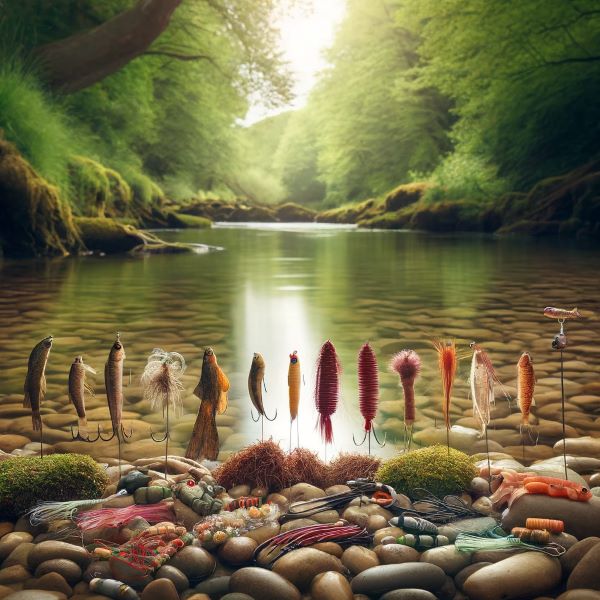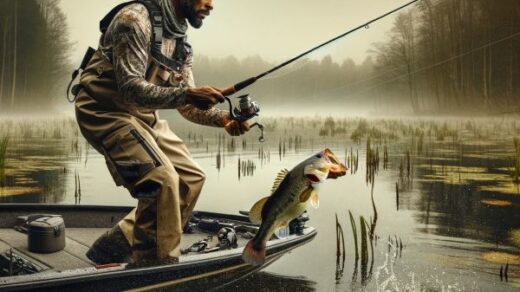
The key for creek fishing is downsizing baits, fishing slowly and precisely around cover and structure where fish are holding. Topwater lures like poppers and buzz baits can also be effective options during summer. Here are some of the best options:
- Worms: Live worms, such as nightcrawlers or red wigglers, are very effective because they’re a natural part of the diet of many creek fish. They can be used on a simple hook setup and are especially good for catching trout and panfish.
- Insects: Live insects like crickets, grasshoppers, and mayflies are excellent for mimicking natural prey. These work particularly well in areas where fish are used to feeding on surface insects.
- Small Minnows: Live or artificial minnows can be very effective, particularly for predatory species like small bass or larger trout. The swimming action of the minnows attracts attention in moving waters.
- Artificial Flies: If you’re fly fishing, using artificial flies that mimic local insects can be very successful. Patterns like nymphs, dry flies, and streamers are all useful depending on the type of fish and the current conditions.
- Jigs: Small jigs, typically 1/16 to 1/32 ounce, can be very effective for creek fishing. They can mimic a variety of prey items from small fish to aquatic insects, depending on how they’re used.
- Spinners: Small spinnerbaits with flashy spinner blades can attract fish by reflecting light and creating vibration. These are ideal for more aggressive fish like small bass or trout.
When fishing in small creeks, it’s also important to use lighter tackle and smaller hooks to match the smaller size of the creek’s fish. This not only makes the fight more enjoyable but also reduces the risk of injuring the fish.
Tailored Baits for Targeted Success: Matching the Right Baits to Creek Fish Species
let’s delve deeper into the specific types of baits that are particularly effective for various fish species commonly found in these environments:
Exploring Baits for Common Creek Fish
- Trout: Often the stars of small creek fishing, trout respond well to live worms like nightcrawlers and red wigglers, which mimic their natural diet. When these are not available, artificial flies—especially nymphs and dry flies—are perfect for imitating the small insects that trout feed on.
- Panfish: Including bluegills and sunfish, these small but feisty fish are particularly attracted to insects. Using live bait such as crickets or grasshoppers can yield great results. For those who prefer artificial baits, small jigs or soft plastic grubs in bright colors can be very effective.
- Smallmouth Bass: This species, while larger than most creek fish, can still be targeted in streams. Small live minnows or artificial minnows work well, as do crayfish imitations, which are part of their natural diet. Soft plastics rigged on light jig heads can also be productive, particularly in natural shades that blend into the creek environment.
- Creek Chub: A common yet often overlooked creek resident, creek chub can be caught using simple baits like dough balls or small pieces of worm. For a more active approach, tiny spinners that flash in the light can be irresistible to these curious fish.
- Brook Trout: For those in clearer, cooler waters, brook trout are a delight to catch. They are particularly responsive to flies that simulate aquatic insects, but small spinners can also work well in stirring their interest without spooking them.
- Perch: Yellow and white perch can be found in deeper pools of creeks and respond well to small minnows or worms. Lightweight spoons that create a subtle flash in the water can also attract perch, especially on sunny days when the light reflects off the metal.
By using these targeted approaches and adjusting your tactics to the type of fish you’re after, you can enhance your creek fishing experience. Remember, the key to successful small creek fishing lies in the subtlety of your approach and the ability to adapt to the preferences of the local fish. Whether using live bait or artificial alternatives, the right choice will not only increase your chances of a good catch but also make your fishing excursion more enjoyable.
Ideal Fishing Rod Characteristics for Creek Fishing:
1. Rod Length:
- Short to Medium Length (5 – 7 feet): These lengths are best for small creeks because they offer greater accuracy and ease of handling. They allow for precise casting in confined spaces and are easier to maneuver when surrounded by dense foliage or uneven terrain.
2. Rod Action:
- Fast to Moderate Action: A fast-action rod is responsive and bends mostly near the tip, which provides good sensitivity for detecting light bites and quick hook sets. Moderate action rods offer more flexibility, which is useful for a variety of lure types and fishing techniques used in creeks.
3. Rod Power:
- Light to Medium Power: Light power rods are perfect for the smaller fish typically found in creeks, such as trout and panfish, using lighter lines and smaller lures. Medium power rods provide a good balance for slightly larger species or when using slightly heavier lures or baits.
4. Rod Material:
- Graphite: For creek fishing, a graphite rod is often preferred because of its light weight and high sensitivity, allowing anglers to feel subtle bites and the bottom structure. Graphite rods are excellent for precise techniques and delicate presentations.
5. Handle Type:
- Cork Handles: These are generally preferred for their comfort and sensitivity. They allow better transmission of vibrations through the rod to the angler’s hand, which is crucial for detecting subtle bites common in creek fishing.
Recommended Setup:
- Rod: A 5.5 to 6.5-foot graphite rod with fast to moderate action and light to medium power. This setup offers the best blend of sensitivity, precision, and versatility for creek environments.
- Reel: Pair the rod with a lightweight spinning reel for ease of use and balance. Spinning reels are preferable for their ability to handle lighter lines and lures, which are typical in creek fishing.
- Line: Use a lighter line, typically 4-8 pound test, to match the light tackle setup and to ensure natural bait presentation, which is crucial in the clear waters of a creek.
This type of rod setup will allow you to effectively target a variety of fish species found in creeks, providing both the flexibility to use different lures and the precision needed for successful creek fishing.
Key Techniques for Stealth and Success
Stealth and Approach
- Stay Stealthy: Fish in small creeks are often skittish due to the clear water and close quarters. Approach the creek quietly and try to stay out of direct sight. Avoid casting shadows on the water.
- Wade Carefully: If you need to enter the water, move slowly and deliberately to minimize disturbance.
Casting Techniques
- Short and Accurate Casts: Due to overhanging trees and bushy banks, long casts are usually not necessary or practical. Focus on making short and accurate casts to spots where fish are likely to hide, such as under logs, around boulders, or near undercut banks.
- Bow and Arrow Cast: This technique is useful when fishing in areas with dense foliage. Hold the lure or fly in one hand and bend the rod with the other, then release it to “shoot” the bait into tight spots.
Choice of Lure or Bait
- Match the Hatch: Use baits that mimic the natural prey in the creek, such as small insects, minnows, or crustaceans. Artificial flies, small spinners, and light jigs are effective.
Reading the Water
- Identify Holding Spots: Fish often hold in areas where the current is slower, behind rocks, or where there is a sudden depth change. Cast into these areas and let your bait drift naturally with the current.
- Look for Riffles and Pools: Riffles can hold smaller fish and insect larvae, which attract larger fish. The deeper pools that follow riffles are often resting spots for fish, making them ideal targets for your bait.
Adjust Your Strategy
- Be Flexible: Be prepared to change your tactics based on what the fish are responding to. If one technique or bait isn’t working, switch to another until you find what works.
- Seasonal Tactics: Keep in mind that fish behavior changes with the seasons. For example, trout are more likely to be found in faster-moving water in the summer as they seek oxygen-rich areas.
Using these techniques will not only increase your chances of success when fishing in small creeks but also enhance your overall experience by aligning your strategies with the natural behavior and habitat of creek fish.
Wading through a creek is an enjoyable and memorable way to enjoy the summer and stay cool. However, it’s important to stay safe and prepared. Always keep your phone handy and stay alert to your surroundings. Bring along a variety of small lures and the most adaptable rod you have. Whenever possible, move upstream, aiming for shaded areas, shoals, wood, and any other features that disrupt the current. Above all, remember to have fun—that’s the essence of creek fishing!




